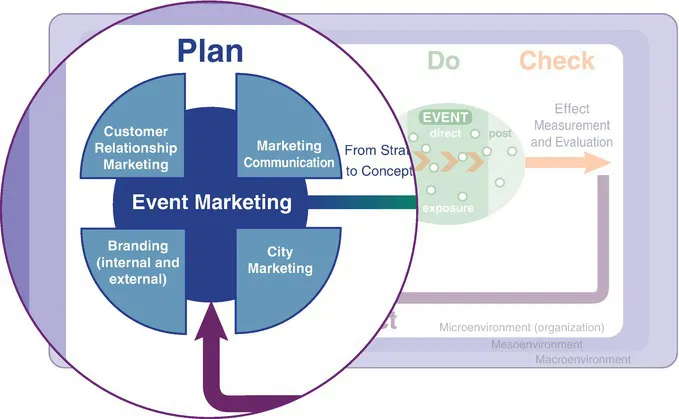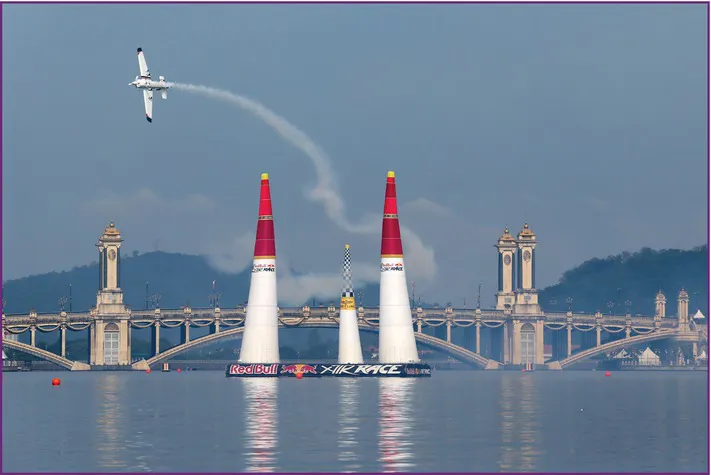![]()
Part I Plan
Part I is about the planning phase of the strategic use of events, which involves the left side of the EVENTS model (see Fig. 1.3).
After two introductory chapters, we will deal first with the subject of event marketing as a tool. After that, we will present four forms of marketing in which this tool is used.
1. Introduction: Using Events as a Strategic Marketing Tool
2. Trends and Developments: Consumers’ Pursuit of Happiness
3. Event Marketing
4. Events and Customer Relationship Marketing
5. Events and Marketing Communication
6. Events and Branding
7. Events and City Marketing: The Role of Events in Cities
![]()
1 Introduction: Using Events as a Strategic Marketing Tool
In this chapter we will explain what events are and how organizations can use them strategically. Moreover, we will discuss several types of events and introduce the EVENTS model. Finally, the structure of this book is described, with a preview of Chapters 2 through 10.
Learning Targets
After studying this chapter, you will have learnt:
• how events can be used strategically;
• what a strategically used event is;
• which types of events there are;
• what the main differences between the various types of events are; and
• how the EVENTS model works.
The Strategic Use of Events
This book is about the strategic use of events; about the ways in which organizations use events like air races to achieve underlying objectives. This is referred to as a strategic use of events because the event is part of a strategy – a carefully thought-out plan to achieve a certain goal. The event is the carrier of the message: in other words, it is a communication tool. Marketers and other communication professionals use events to get their message across to a specific target group or to increase customer loyalty. Messages range from ‘Buy this product’ to ‘Nothing beats Groningen’.
The Emergence of Events as a Strategic Marketing Tool
Marketers and communication professionals use events as a strategic marketing tool more and more often. According to MOSAIC (www.eventmarketer.com), the corporate community is currently spending about 25% of its marketing budget on organizing events.
Where does this increasing popularity come from? We believe there are three explanations:
1. Target groups are becoming increasingly intangible to marketers. Many traditional marketing communication tools have lost much of their ability to capture the target group’s attention. Newspaper subscriptions have been declining for many years, for instance. This means that marketers today reach fewer people through newspaper advertising. The same holds true for radio and television: due to the steady growth in radio and television channels, viewer and listener attention becomes fragmented. All this has forced marketers to look for alternative means of communication. Strategic events are one of these alternative means.
2. Events are effective tools to ingrain your message in the audience’s mind. They are perfectly suitable for adding a layer of emotional value to a product or service. Visitors to an event undergo the event and experience it, and the event gives them lasting memories to cherish. As a result, the message of the event will stick – provided that it is communicated in the right way, of course. In a time when products and services, and cities too, become more and more alike, this is a good way to distinguish yourself.
3. Events are excellent tools to contribute to the quality of life in a company or, for instance, in a city or part of a city. Events foster social cohesion, thanks to their interactive character.
The sound of a roaring engine: a small plane skims past a gigantic, cone-shaped pylon, turning in the direction of a slender white bridge. When the pilot manoeuvres his plane under the bridge, the crowd holds its breath: will the daredevil survive this stunt?
Red Bull has created an international series of air races (see also Chapter 6) in which competitors have to navigate a challenging obstacle course. Pilots fly individually against the clock and have to complete tight turns through a slalom course consisting of pylons and bridges. Admission to the event is free, and it draws huge crowds. Red Bull manufactures the popular energy drink of the same name, and finds itself in the same league as Vrumona, Spa and Heineken. Its core business is producing, bottling and distributing energy drinks. Why would this company engage in organizing air races?
Red Bull has created the air race series for marketing purposes. The air races are part of a sophisticated strategy. The company organizes the races to give the Red Bull brand a sporty and adventurous image. This image is supposed to help Red Bull distinguish itself from its competitors, who sell more or less similar energy drinks. The adventurous image is supposed to tempt customers to single out Red Bull rather than, for instance, a can of Slammers.
To Red Bull, the air race is therefore not an end but a means: the drinks manufacturer organizes the races for strategic reasons – for brand strategy reasons, to be precise. The event is a tool to achieve the underlying objective of creating an adventurous and sporty image. This does not mean, however, that the specific nature of the event is irrelevant. Red Bull deliberately opted for air races and not poetry reading sessions.
Event Marketing
The discipline that involves using events as a live means of communication is referred to as event marketing. Event marketing is marketing practices based on the use of events. In event marketing, events are part of, for instance, a communication campaign or a branding strategy. Sometimes the events are organized once (on a one-off basis), sometimes several times (on a regular basis). Chapter 3 addresses the subject of event marketing more extensively.
Event marketing is applied primarily in four types of marketing:
1. Customer relationship marketing: building, maintaining and intensifying relations with various parties (see Chapter 4).
2. Marketing communication: marketing products and services by influencing the visitor’s knowledge, attitude and behaviour (see Chapter 5).
3. Branding: influencing, creating or changing valuable associations that a visitor has with a brand (external branding) and/or influencing, creating or changing valuable associations that an employee has in order to increase employee engagement and optimize the customer experience (internal branding) (see Chapter 6).
4. City marketing: ‘selling’ a municipality or region to current and potential residents, visitors/tourists and businesses or organizations (see Chapter 7).
These four types of marketing will be covered in Part I of this book.
Using Events as a Strategic Marketing Tool
Using events as a strategic marketing tool: now what does this mean precisely? In this book, we use the following definition:
Using an event as a strategic marketing tool involves planning a unique event or series of events for one or more target groups where people come together, either physically or virtually, at the invitation and initiation of a company/business, government body or non-profit organization. The client wishes to achieve an emotional added value by means of an experience, to support a predefined objective (communicative or otherwise) that has to be achieved among one or more of the target groups identified.
This type of event has a number of characteristics. The event:
• is a planned, unique, physical or virtual event or series of events for one or more target groups;
• is held at the invitation of an organizing party; this invitation may also be public, so for everyone;
• is aimed at achieving an emotional added value to support the communicative objective of the organizing party;
• creates an emotional added value by means of an experience.
Several of these elements are reflected in our Red Bull example. After all, it involves:
• a planned event: the race and its spectators;
• a target group: consumers who are interested in spectacular adventurous sports;
• an invitation: Red Bull announces to the general public when and where the races will take place;
• an emotional added value: the aim of the race is to create a distinct image for the brand;
• an experience: spectators experience the excitement and sensation of the race.
Experiences
The definition in the section above shows that experiences are an important factor in the strategic use of events. But how does this work? Why does Red Bull expect that the spectators at the air race will associate the brand with sports and adventure afterwards? In a nutshell, it works as follows – before, during and after the event. Visitors to an event are exposed continuously to sensory impressions. They see, hear and undergo all sorts of things. These impressions lead to an emotion; for instance, enthusiasm or aversion. As a result, the visitor experiences the event as either pleasant or terrible. After the event, the visitor takes stock (unconsciously). The event as a whole has then become an experience. It is precisely because events are sensory experiences that the visitor is especially open to any messages communicated during the event. The visitor to the race organized by Red Bull is part of the spectacle. He feels the excitement, is engaged emotionally and feels a connection with the values of Red Bull. From now on, spectators will associate Red Bull with adventure and spectacle, either consciously or unconsciously.
The explanation we have given here is a strong simplification and certainly not based on any academic sources. The psychological processes that are involved in acquiring experiences and associations are complex. There are numerous factors that play a part in the visitor’s experience of an event: the visitor’s mood, interests, previously acquired experiences, social environment and background. The better an event aligns with these personal factors, the more meaningful the event will be to the visitor concerned. Chapters 8 and 9 of this book will consider this in more detail.
Touchpoints
The way in which an event is experienced is determined to a high degree by the visitor’s experience of what are referred to as touchpoints. Touchpoints are interaction points between the organizer of the event and the visitors to the event; in other words, all communication and contacts between visitors and representatives of the organization. Sometimes, these points of contact are orchestrated carefully and deliberately by the organizer, and sometimes they occur accidentally. Touchpoints occur not only during the event but also before and afterwards. Take, for example, the Red Bull air races. In the pre-event phase, the organization announces the event to the target group, the general public...




